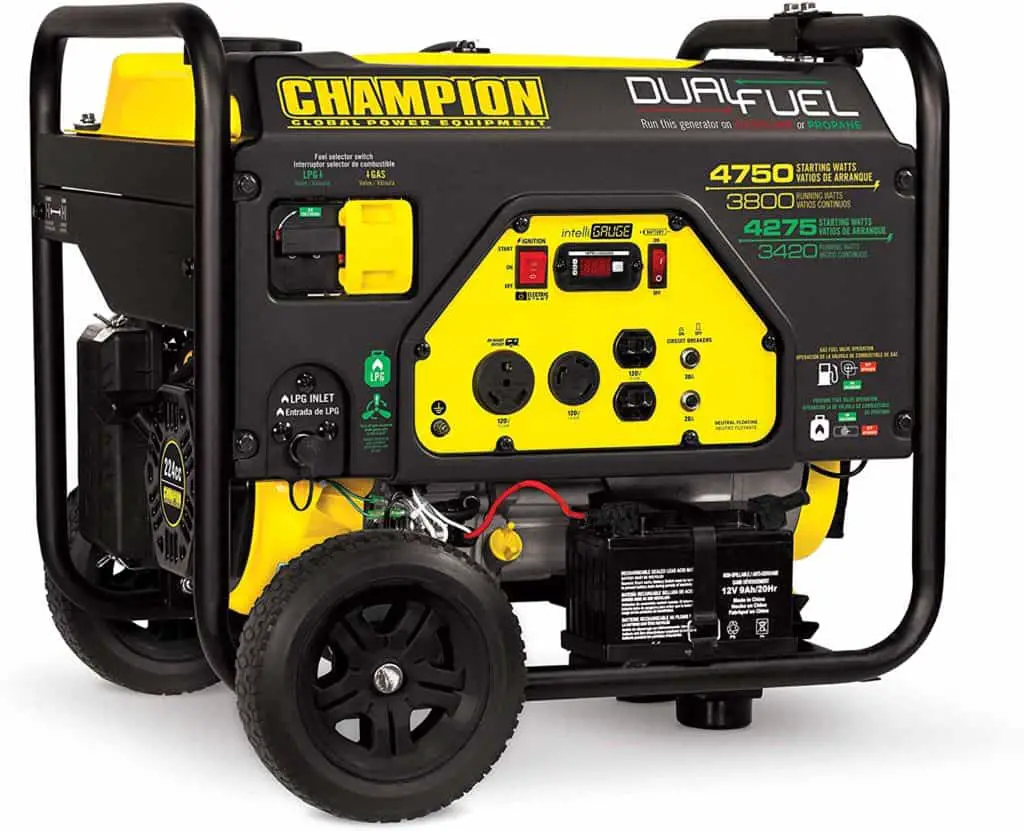When I woke up the other morning it was below 20 degrees Fahrenheit and my wife and two little boys were still snuggled up in their nice warm beds. Thanks to the furnace that was running, pumping warm air through the vents and into each room in our house. But… What if the power went out? How long could we stay warm? Inevitably, my inquisitive mind couldn’t help but wonder, “How do I prepare for and survive a power outage in the winter (cold weather)?”
To prepare for a winter power outage make a list of everything that you need and then make a plan and budget to start acquiring everything. It is imperative that you have water, food, heat, and lighting. Additionally, you will need to make preparations and plans for keeping warm, preparing meals, storing emergency items, etc. Essentially, putting together a 72-Hour kit with cold weather in mind will prepare you for a winter power outage.
It is important to know how to Keep Warm During a Power Outage and Safely Cook Indoors During a Power Outage.
In this article, we have made a list of important things to have and key considerations to make in preparing for a winter power outage.
Winter Power Outage Supplies, Checklist, and Tips
- Water – Keep enough drinking water for each member of your family to make it through a minimum of 2 weeks. Packages of bottled water are great for this and the water stays good for years as long as the bottle’s seals aren’t broken.
- Food – Have enough nonperishable food for each family member to survive at least 2 weeks without power.
- In case of a power outage, eat food from the refrigerator first, then from the freezer, then from storage. In a well-insulated freezer, foods are usually good for 2 days if there are still ice crystals in the center of the food. Keep the fridge and freezer doors closed as much as possible. (FEMA)
- Warmth (heat) – consider alternative emergency heaters, such as Kerosine Heaters or wood-burning stoves, for heating your house during a power outage.
- Backup Power supply – Consider investing in Solar Panels or a Generator (jump down the page to see generator recommendations)
- Emergency Lighting – Stock your home with enough flashlights for everyone in your family and make sure to keep extra compatible batteries. Getting battery-powered LED lamps to place around your home is also very handy. If you are careful, candles also produce extra light in a power outage.
- Medical Devices and Medication – Talk to your medical provider about a power outage plan for medical devices powered by electricity and refrigerated medicines. Find out how long medication can be stored at higher temperatures and get specific guidance for any medications that are critical for life.
- Portable Battery Banks – Always have a couple of portable battery banks that are ready to charge your mobile phones and other important electronic equipment.
- Gas in Car – Keep at least half a tank of gas in your car at all times. Many gas stations rely on electricity to power their pumps. While it may seem inconvenient to make more frequent stops at the gas station, if you have a near-empty tank during a power outage, you may lack the fuel to travel in an emergency.
- Full Emergency Gas Tank – Keep an extra gas tank full for emergencies.
- Portable Camping Stove – Getting a portable camping stove is a great idea for not only cooking and boiling water while camping but for emergencies. Having a stove to cook with and heat water during a power outage will be indispensable.
- Extra Propane Tanks – Storing extra propane tanks that you can use for fueling a grill, portable stove, or propane heater.
- Cash / Money – Keep at a minimum 1 Month worth of expenses in cash at home. This should be more than enough to get you through a short winter power outage. However, ideally, you should keep enough cash for 3 months’ worth of expenses just in case of a larger scale emergency or financial hardship.
- Extra Batteries – Plan for batteries that are compatible with important electronics like radios.
- Sign up for local alerts and warning systems and monitor weather reports. Be prepared for expected storms.
- Install carbon monoxide detectors with battery backup in central locations on every level of your home
- Take an inventory of all the items you need that rely on electricity.
- What supplies do you have available in case of a power outage and what more can you add?

How do I keep warm when the power goes out in the winter?
To keep warm when the power goes out during the winter, you will need to have a nonelectric source of heat, warm (wool) blankets, and warm clothes (coats, stocking hats, gloves, etc.). It is important to consider nonelectric forms of heating such as kerosene space heaters, wood-burning stoves, or a fireplace is great if you can have one installed in your home. Additionally, consider buying cold weather/winter sleeping bags 20°F (-6.6 °C) and below for every member of your family. Consider an alternative source of power such as an emergency home generator. Even smaller, portable generators make a great source of emergency power. Check the generators Wattage output and consider what you want to be able to power before buying one. See our “best overall” and “best value” picks for generators farther down in this article.
Ideas to Keep Warm in the Winter
- Insulate your home by installing storm windows or by covering single-pane windows with plastic from the inside. Weatherstripping around your doors and window sills can also help to keep warm air in.
- Keep extra blankets, sleeping bags, and sweaters nearby so you can bundle up if needed.
- If your budget allows, buy a portable generator. Learn how to safely use the generator and test it monthly. Remember to store enough fuel to run the generator for a week.
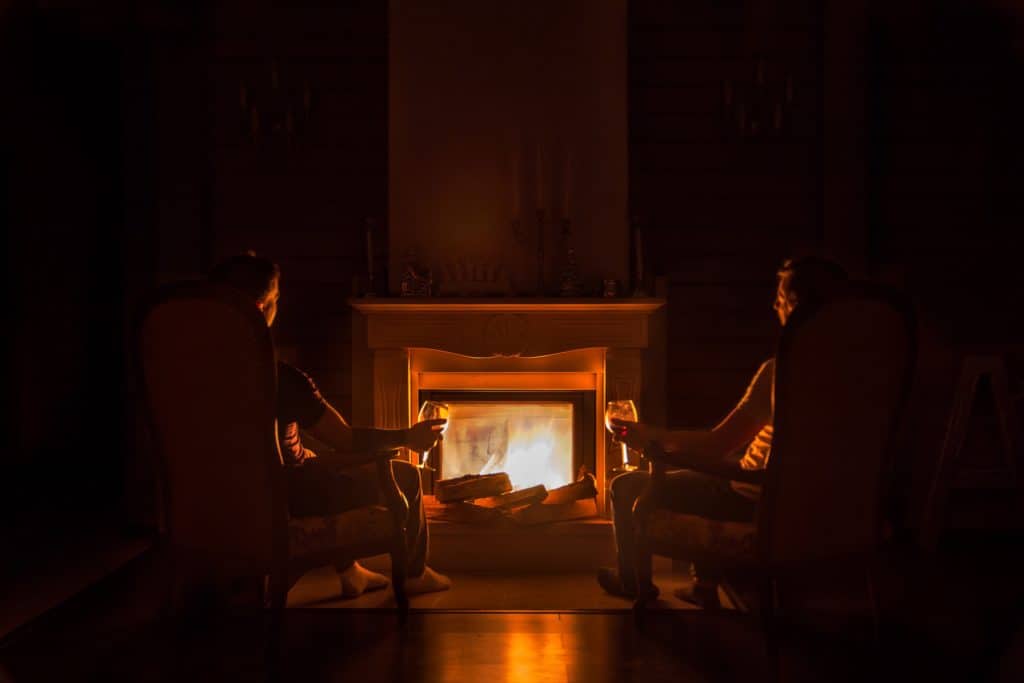
Ways to Stay Warm in the Winter
- Kerosene Space Heaters
- Mr. Heater Buddy Heaters
- Wood-burning Stoves
- Fireplaces
Kerosene Heaters
Kerosene Heaters are one useful way to keep your house warm. They burn clean and the newer ones have safety features, such as shutting off if they’re tipped over, which makes them safe to heat rooms inside your home.
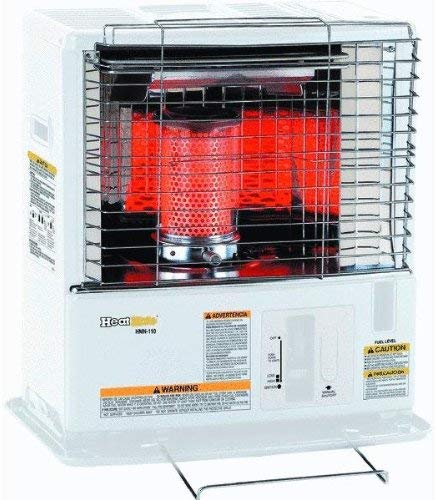
Whether you want a cheaper way of zone heating your home or if you simply need a backup heating solution for power cuts in the winter months, you should check out the Sengoku CTN-110 KeroHeat 10,000 BTU Portable Radiant Kerosene Heater on Amazon.
This heater is highly portable and has a small size, but despite being compact, this is a powerful 10,000 BTU heater that is able to heat larger rooms in your home.
The 1.2-gallon fuel tank allows you to run this heater for up to 14 hours without needing to refuel, offering you convenience when you need it. It comes with a siphon pump so that you can empty the tank when you want to move or store the heater and it also comes with 4 C sized batteries, which are required for operation.
Click here to check the price of this Kerosene Heater on Amazon
Don’t forget to store enough Kerosene to keep your heater running for an extended period of time. Kerosene heaters are very useful but only if you have enough Kerosene to keep them going! Check out this Kerosene Fuel on Amazon.
Safety First
Make sure that you are being safety-minded in everything that you do. Heat is essential in cold weather and people have been lead to make poor choices in providing heat in their homes during power outages. All types of heaters have potential hazards so know how to properly and safely operate whatever you choose to heat your homes during an emergency.
Safety Tips
- Make sure whatever you use is clean and operational.
- Test your kerosene heater before each storm
- Have your chimney cleaned and inspected every year.
- If you plan to use a wood-burning stove or fireplace, store dry wood during the winter months.
- Keep all heat sources at least three feet away from furniture and drapes.
- Keep a fire extinguisher on hand and make sure everyone in the house knows how to use it.
- Make sure that there are batteries in your smoke detectors and carbon monoxide detectors so that they will be operational during a power outage.
Heating your house during a power outage
Mr. Heater Buddy Heaters (Radiant Heater)
4,000 / 9,000 BTU | Heats 225 sq. ft. & a little more | Auto shut-off if tipped over or detects low oxygen
- Heats 225 sq. ft. but I have found it to work in a space up to 300 sq. ft.
- 4,000 / 9,000 BTU of radiant heat
- Runs on 1 lb. propane cylinder(s)
- low & high heat settings
- Runs for up to 5.4 hours on low & 2.4 hours on high
- Auto shut-off if tipped over, if pilot light goes out, or if detects low oxygen levels.
Check the price of the Buddy Heater on Amazon
I own two of Mr. Heater’s Buddy heaters and use them in my garage and even inside my house when the power goes out. The company that sells these heaters says that they are safe to use indoors. I was a little hesitant to use the heater inside my house initially because of the propane but I have now used it several times and I found them to be safe. I still won’t run the heater all night while I sleep, out of caution, but the heater has done a great job heating parts of our home when needed.
This heater has done a great job and keeping our living room warm which is about 300 square feet. It will be satisfactory for most apartment living rooms, smaller home living rooms, and for most bedrooms.
Safety is important! It is important to know that it uses propane and pilot light for the radiant heat to work. Be careful to not leave it unattended because if it types over it could still catch something on fire even though the auto shut-off turns it off if it’s tipped over. Always keep a close eye on the heater when it is running and never stick anything to close to the heating element.
How do you get power when the power goes out?
The most common way to get power during a power outage is by using a generator, solar panels, personal windmills, or other alternative power sources.
Get Power by Using a Generator
Consider a generator as an alternative power source to power electric space heaters as well as other appliances in your home. With a little help from an Electrician, for not much more than a couple hundred dollars of labor, you can get a transfer switch setup off of your home’s electrical panel for a backup generator. This way you can tie the power output from a generator right into the electrical panel of your home. Then according to the Wattage output of the generator, it will power what you want in your home and you won’t have to worry about running power cords in through a window or door which would allow precious heat to escape from your home. Make sure you ask your Electrician questions and know all best practices to safely tie in power from your generator to your home.
Best Generators for a Power Outage in Winter – best power supply for power outages
- Champion Dual-Fuel 3800-Watt Portable Generator
- Duromax XP12000EH 9,500-Watt Portable Generator
Champion Dual-Fuel 3800-Watt Portable Generator
3800 watts | 224cc Champion 4-Stroke Engine | 3.4 gallon tank | 68 dB | 119 lb.
Pros
- Dual fuel
- Cold-weather start
Check the price of this Champion Generator on Amazon
This generator is loaded with plenty of power and features to get you through a storm. It’ll run on propane for up to 10.5 hours or gas for up to 9 with a full tank. In addition to its easy push-button start, its cold-start technology improves its ability to start in cold weather, which is especially useful when the power goes out due to a snowstorm. Features such as its cast-iron sleeve for durability, built-in surge protection, oil sensors, folding handle for storage, and variety of outlets also make it a great buy.
Champion Dual-Fuel 3800-Watt Portable Generator Review
Duromax XP12000EH 9,500-Watt Portable Generator
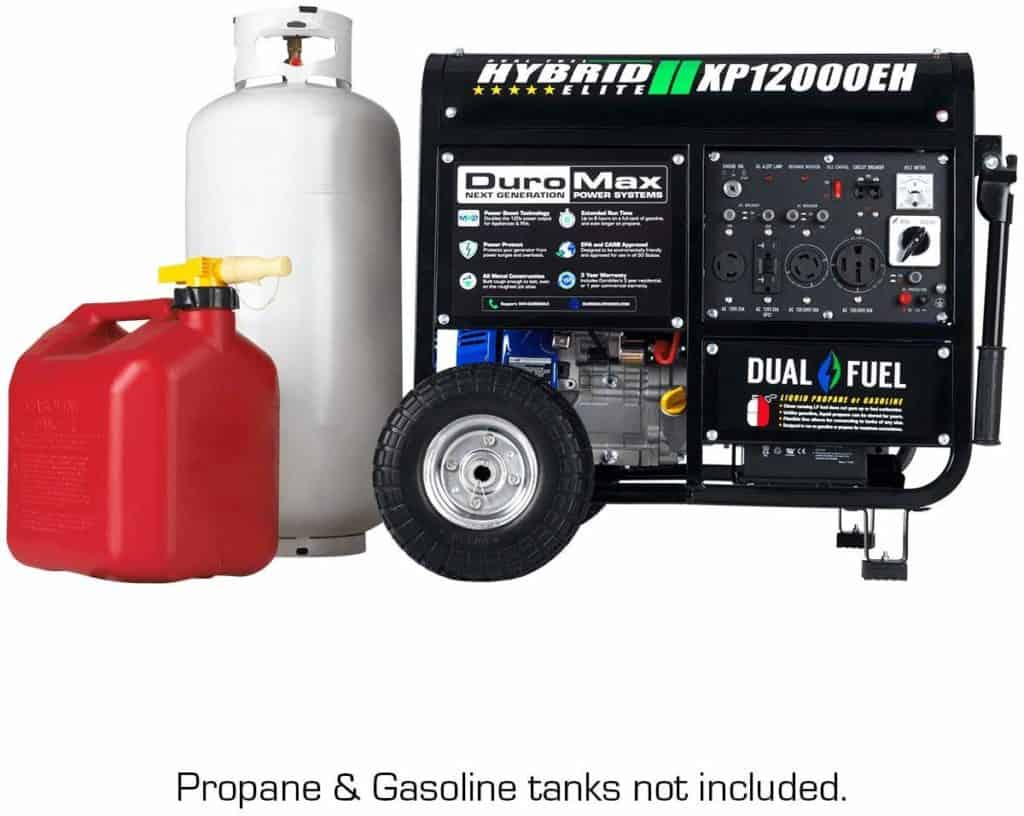
9,500 watts | 18HP 457cc OHV Engine | 8.3 gallon tank | 74 dB | 260 lb.
Pros
- Dual fuel
- Heavy-duty frame
- 9,500 watts of output power
Cons
- Expensive
- Heavy
Check out the price of this Duromax Generator on Amazon
With a maximum of 12,000 watts, this Duromax is one of the most powerful portable generators. Its dual-fuel capability allows it to run on propane or gas. A 20-pound propane tank at 50 percent max output will provide 20 hours of power, and gasoline at 50 percent will run for 10 hours. While it has a user-friendly electric start, recoil start is also optional. This generator’s heavy-duty metal frame will protect it when outside in stormy weather, and the power panel includes individual breakers for safety. Though it’s a heavy appliance, the solid-fill wheels will help you transport it around the house when necessary. All Duromax generators are also approved by both the EPA and CARB and have a three-year warranty.
Emergency Food Storage
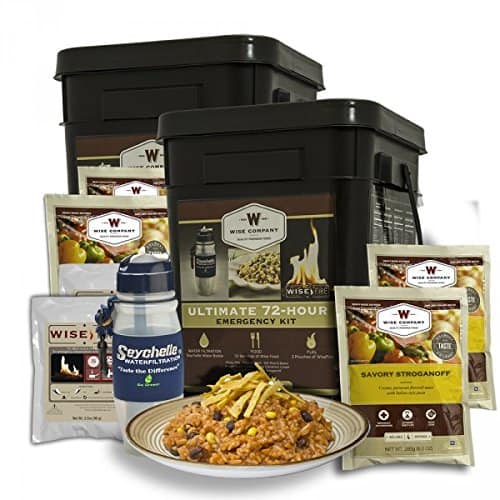
Consider acquiring an Emergency 72-hour Food Kit that only needs water to cook. It can be bought in prepackaged servings or bulk. It is perfect for storms, power outages, natural disasters, and much more. Having this emergency 72-hour food supply when stores are not accessible will be life-saving. You can keep this bucket at home, store in an RV, or bug out (leave home quickly) vehicle for on-the-road meals. Try Wise Company’s 72 Hour Emergency Kit, Food Supply, Water Filtration, and Fire Starter (Check the price on Amazon). As far as freeze-dried meals go we enjoy Wise Company’s food and highly recommend this 72-hour emergency food kit.
To learn more about 72-hour kits check out our article 72 Hour Kit Guide & Checklist For The Whole Family With PDF Download.
What do you do when you have no power in the winter?
As important as it is to prepare your family to survive a power outage, especially in the winter or cold weather, it is also important to plan some activities for your family. So many people and kids have become dependent on phones, social media, TVs, and electronic games. It may be worth planning games or activities that don’t require any electronics or an internet connection. Additionally, we find it very fulfilling and important to help our neighbors. Consider sharing wool blankets or finding ways to help neighbors survive short winter power outages. Often this can best be done by working with local churches and nonprofits.
Conclusion
It is imperative that you acquire all that you need to survive a power outage in winter cold weather. Also, plan to maintain and keep up to date all the supplies or kits that you have put together. Food and water don’t stay good in storage forever. Other items need to be checked on such as heaters and generators to make sure that they are in good working condition. Having gas or propane to run heaters, stoves, or other devices is essential. Make a plan, write it down, check on it routinely (put a reminder in your phone), and watch the weather so you can prepare for upcoming storms. My family’s safety and protection is the most important thing to me so I view preparing for emergencies as an absolute must. I hope this article is helpful and that you all chose to be prepared for a winter power outage or other emergencies that may come your way. Good luck!
Centers for Disease Control and Prevention – What You Need to Know When the Power Goes Out Unexpectedly
FoodSafety.gov – Winter Weather Food Safety
Red Cross – Winter power outages: Are you prepared?



